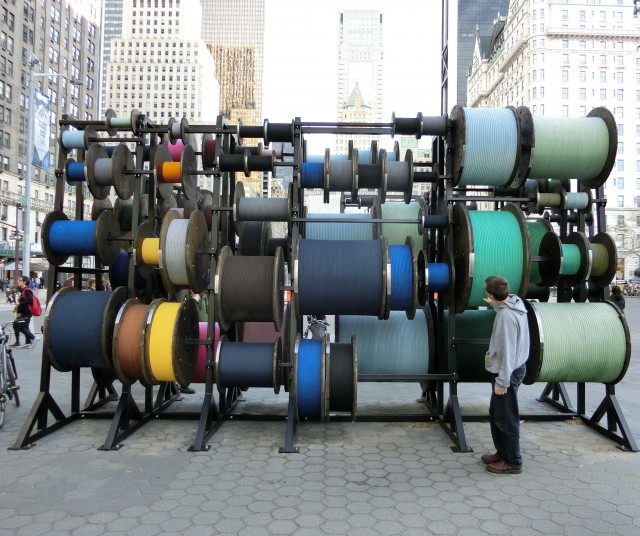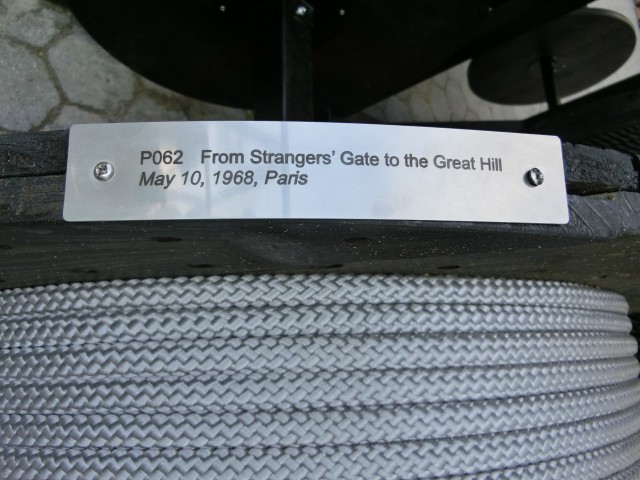
Tatiana Trouvé’s “Desire Lines” reimagines the pathways of Central Park into spools of rope (photo by twi-ny/mdr)
Scholar’s Gate, Doris C. Freedman Plaza
Central Park entrance, 60th St. & Fifth Ave.
Through August 30, free
www.publicartfund.org
desire lines slideshow
Paris-based Italian artist Tatiana Trouvé gives 212 pathways in Central Park sculptural form in “Desire Lines.” For her first public exhibition in the United States, Trouvé has mapped out the length of these trails, turning each one into a wooden spool of colored rope stacked together on three metal storage racks at the Scholar’s Gate entrance to the park at Doris C. Freedman Plaza on Sixtieth St. and Fifth Ave. Ranging from about sixty feet to four miles, each length of rope has a name selected by Trouvé to represent the landscape of the park as well as political and artistic statements involving walking, making the time and space of the park tactile, something you can actually touch. Among the names of the spools are “[P063] From East 84th Street to the Reservoir’s south gate house: Belo Monte Protest,” referencing the 1989 marches in Brazil against the Belo Monte Dam; “[P032] From Warriors’ Gate to Artisans’ Gate via West Drive: Prayer Pilgrimage for Freedom,” paying tribute to the 1957 civil rights demonstration at which Dr. Martin Luther King Jr. delivered his “Give Us the Ballot” speech; “[P147] From Cedar Hill towards Miners’ Gate: I’m Walking,” a nod to Fats Domino; “[P025] A detour to the West Drive boat landing: Narcoturismo,” an homage to Francis Alÿs; “[P044] From Scholar’s Gate, around the Dairy and past Cop Cot: Hands Up Walk Out,” calling out specifically the shooting death of Michael Brown and other unarmed men by the police; and “[P062] From Strangers’ Gate to the Great Hill: May 10, 1968, Paris,” referring to the violent student protests in France.

Tatiana Trouvé’s “Desire Lines” honors artistic statements and political protests involving walking (photo by twi-ny/mdr)
There are also spools that represent Lou Reed, David Hammons, the Ronettes, Charles Baudelaire, Yoko Ono, the Pixies, Janet Cardiff, the March on Washington for Jobs and Freedom, the Selma to Montgomery March, and the 1913 Woman Suffrage Parade. Two of the three racks consist of rope of different colors, from blues, grays, and purples to pinks, yellows, and greens (one stack features bright colors, the other more muted hues), while the third is limited to spools of black rope only. Besides being pretty to look at, “Desire Lines” encourages you to walk through the park, a rather healthy activity, following in the footsteps of others, while also reminding you that taking to the streets in marches can have an effect on the world. Central Park can be a daunting space, but Trouvé, whose previous work has incorporated such objects as mattresses, shoes, rocks, gym equipment, and stoves, makes it all the more accessible in this appealing, colorful, and poetic three-dimensional atlas.